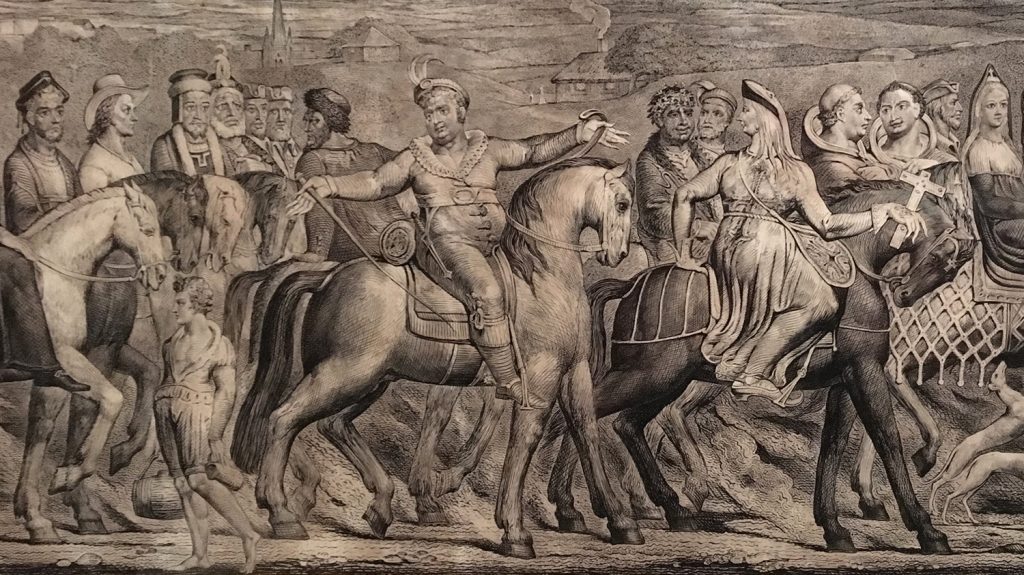Geoffrey Chaucer, the English poet and author of The Canterbury Tales, died today in 1400. The tales are told by a group of pilgrims (seen in the engraving by William Blake, above) setting out from a tavern in Southwark, London, to travel to the shrine of Thomas Becket in Canterbury, and include some very funny – and frequently very rude – satire on the greed and corruption of Church officials. Chaucer died before completing his work, with just 24 out of a promised 120 tales written, but their wit, earthiness and vivid detail bring the world and Church of his time to life in an astonishing way.
‘Come forward, Host, you shall be the first to pay,
And kiss my holy relics right away.
Only a groat. Come on, unbuckle your purse!’
‘No, no,’ said he, ‘not I, and may the curse
Of Christ descend upon me if I do!
You’ll have me kissing your old breeches too
And swear they were the relic of a saint…’
The Pardoner’s Tale, translated by Nevill Coghill
Tadhg Mac Cárthaigh, unlucky Irish bishop, died today near Turin, far from home, in 1492. He trained for the priesthood in Rome, and impressed the Pope so much that even though he was in his 20s, he was appointed Bishop of Ross, Ireland. But when he arrived in his new see, he was shocked to find someone else had been given the job almost a decade earlier by the same Pope. Mac Cárthaigh lost his battle to become Bishop of Ross, but eight years later was appointed Bishop of Cork by a new Pope. In a moment of déjà vu, when he went to Cork, he found that another cleric, with powerful friends and armed heavies at the cathedral doors, had usurped his position. He became a pilgrim, going from place to place with his useless papal documents, until he arrived in a pilgrim hostel in Ivrea, near Turin, where he died. He was 37. He is now venerated in the dioceses which rejected him, and in Ivrea, where he is buried.
Today in 1970, Pope Paul VI canonized 40 British martyrs who lost their lives in the Protestant Reformation in the 16th and 17th centuries. They include Edmund Campion, who was hanged, drawn and quartered in 1581 after leading a secret Jesuit mission to England; and Margaret Clitherow, who sheltered Catholic clerics in a priest hole in her house in York, and who was executed on Good Friday 1586 by being crushed to death, despite being pregnant. This is their joint feast day.
It is St Crispin’s day, which marks the 3rd century martyrdom of the brothers Crispin and Crispinian. It is famous in England as the day of the battle of Agincourt, and for the speech Shakespeare put into the mouth of King Henry V on the eve of the battle.
And gentlemen in England now a-bed
Shall think themselves accurs’d they were not here,
And hold their manhoods cheap whiles any speaks
That fought with us upon Saint Crispin’s day.
Shakespeare, Henry V
It is the feast day of Mar Nestorius, the controversial theologian of the 5th century who is a heretic in most branches of the Church, but a saint in the Churches which went into schism in his lifetime. Nestorius distinguished the divine and human aspects of Christ more sharply than his orthodox opponents, to the point where they accused him of splitting Jesus in two. He was declared to be anathema at the Council of Ephesus in the year 431, sacked as Patriarch of Constantinople, and exiled to a monastery in the Kharga Oasis, deep in southern Egypt, where he died. Sixteen centuries later, his ideas still have the power to generate hot controversy and debate.
Image: Simon Jenkins
